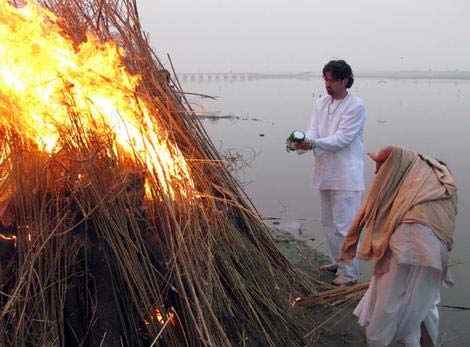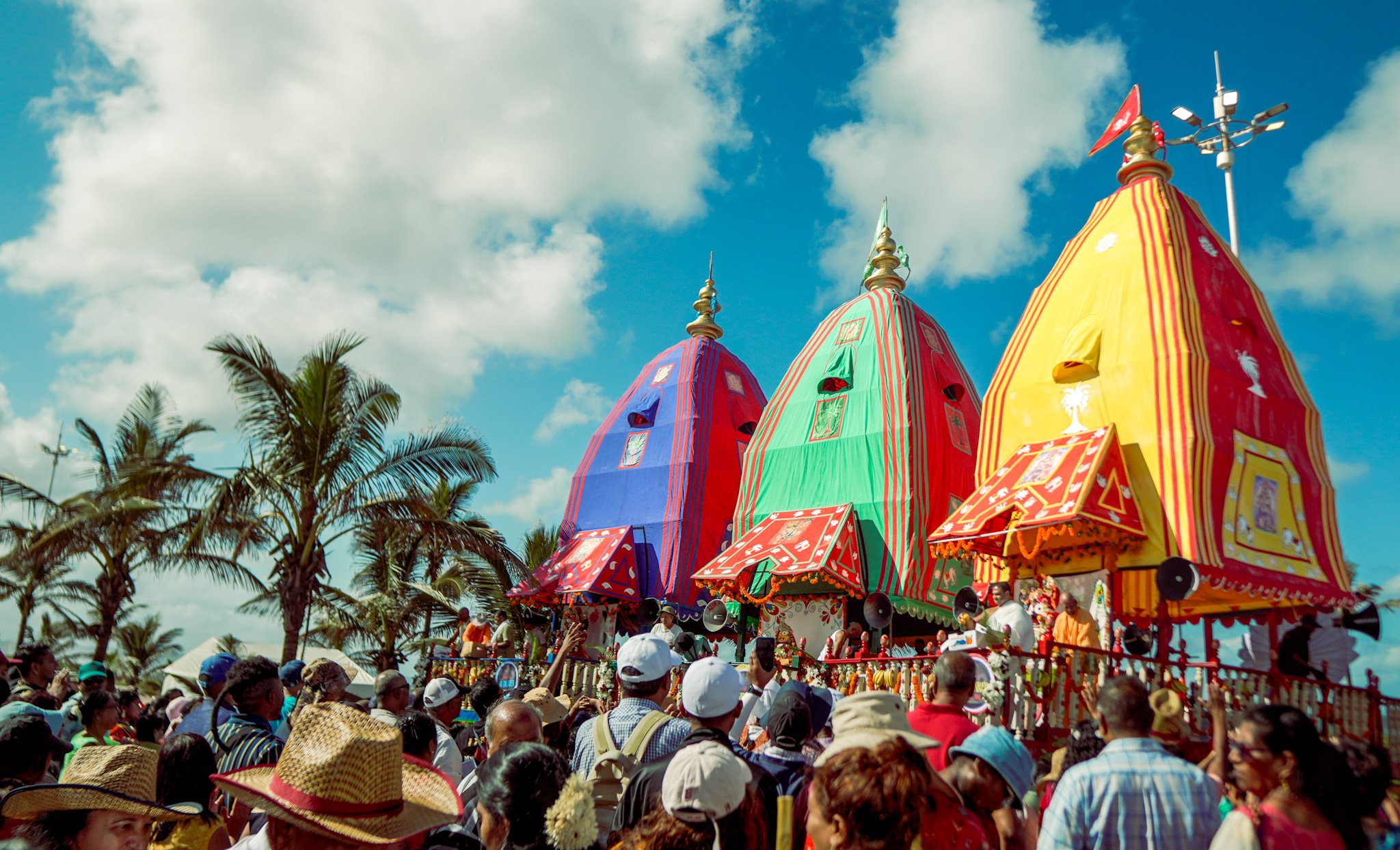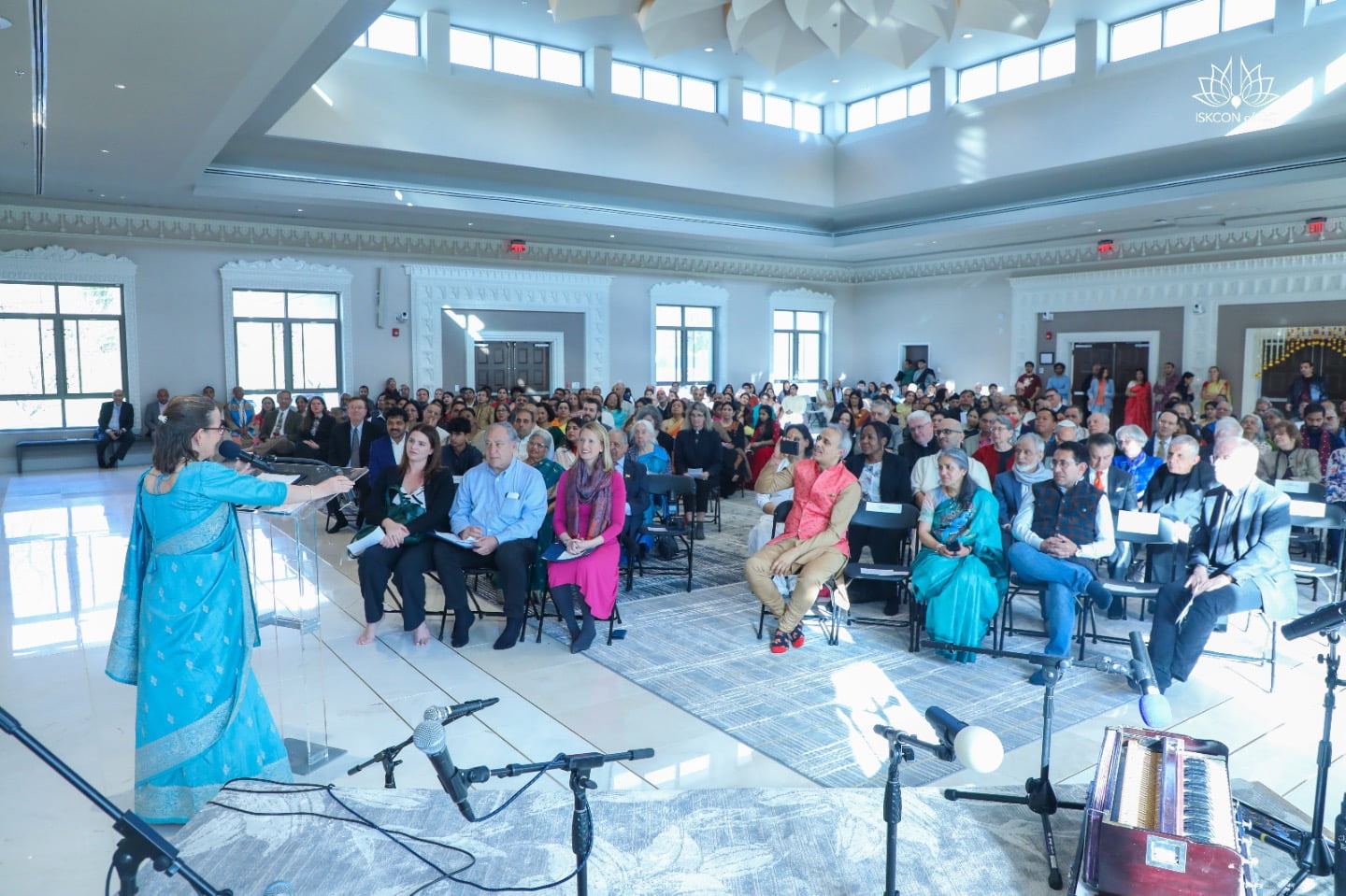Tragic Death Piques Public Interest in Krishna Customs
By Matt Wade | Feb 09, 2008

Zardi Manning gripped the hand of his brother Bhisma as the pair watched the body of their 17-year-old sister Lila burn on a funeral pyre beside India’s sacred River Yamuna.
Anandalila – Lila to her family and friends – died earlier in the day after being shot in the head by a love-obsessed stalker in Vrindavan, one of India’s holiest towns.
“I know there is a lot of grieving to come, but for now I feel happy for her,” said Zardi who, like the rest of his family, is a devoted Hare Krishna.
According to the Hindu tradition, Zardi, 28, and Bhisma, 19, had special responsibilities for Lila’s cremation because they are her elder brothers.
[See multimedia presentation here.]
The pair led the funeral procession through the streets of Vrindavan, stopping off to take Lila’s body around temples that were important to her.
With the help of friends the brothers built Lila’s funeral pyre, a metre from the river’s edge. Zardi helped carry her body into the Yamuna to ritually bathe her before cremation.
But it took a toll. The pain showed on Zardi’s face as he placed logs over the body. At one point he tenderly adjusted the indigo shroud to cover Lila’s face, maybe to hide her gunshot wounds.
The brothers sprinkled the body with substances considered to be auspicious, such as pure ghee and sandalwood powder, in keeping with Hindu custom. Then the pyre was built even higher. It was above head height by the time it was completed.
At dusk Zardi and Bhisma lit the pyre. The sacred songs, which had accompanied the entire ceremony, surged louder as flames started to engulf Lila’s body. “It’s the last part of this journey,” Zardi said.
The brothers and their friends tended the pyre for many hours to make sure everything was burned. It was approaching midnight when Zardi left the fire.
The following day the ashes were collected. Some were put in the holy river and several portions were kept to be sprinkled at other holy sites in India. One portion will be taken to Australia for a special ceremony there.
Lila’s cremation was the culmination of a horrifying three days for the softly spoken Zardi, who lives on the Gold Coast.
He was at the family’s place in Vrindavan early last Saturday morning when Saurav Singh, a 28-year-old local, arrived brandishing a pistol and demanding to see Lila.
Singh had attempted to pursue a relationship with Lila when she was just 14 and he was 24. Zardi demanded that he leave her alone. But his obsession with the young Australian continued.
Singh, the nephew of a former cabinet minister in Uttar Pradesh state, put the gun to Zardi’s chest and threatened to kill him.
“He had been drinking, you could smell it,” said Zardi.
Eventually the gunman and Lila sat in a room to talk while Zardi waited anxiously outside the door. After a long silence the sound of muffled gunshots came from inside.
“I never in a million years thought that would happen,” said Zardi.
He found his sister lying in a pool of blood on the floor having been shot three times in the head. Singh had turned the gun on himself and was dead.
Zardi woke a neighbour to borrow a car and took Lila to a local medical clinic. It was not equipped to deal with such serious injuries so she had to be rushed by ambulance to a hospital in Agra, about 50 kilometres away. Zardi was forced to resuscitate Lila several times on the way and was covered in blood when they arrived. His youngest sister, Marie, just 12 years old, was with him during that traumatic journey.
Lila was stabilised and put on life support and transferred yet again, this time to the huge Apollo Hospital in New Delhi to be assessed by specialists.
They discovered the worst. Lila was brain dead and there was nothing they could do. One of the bullets had splintered and fragments had lodged deep inside her brain.
Lila’s mother, Susan Manning, and father, Ian Salter, arrived in New Delhi from their home on the Gold Coast about the same time as that terrible diagnosis.
“This is every father’s worst nightmare,” said Salter.
The family decided to take Lila back to the holy city of Vrindavan to die.
It was one of Lila’s favourite places and, as Hare Krishna devotees, they wanted her life to end in a sacred place.
“It’s our belief that if a person dies here they are going to heaven,” Manning said. “By doing this we have turned something so bad into something more positive.”
Lila was transported by an ambulance with life support equipment to a guesthouse associated with the Hare Krishna movement in Vrindavan. She was accompanied by volunteer medical staff. A large group of supporters kept vigil around her, singing religious songs accompanied by drums and bells until her heart failed on Tuesday morning.
“Everyone was able to whisper their last goodbyes to Lila,” her mother said.
Lila died in familiar surroundings.
Lila’s family have spent long periods in India with Hare Krishna communities over the past 30 years and are well-known in Vrindavan.
Manning, 48, has been a Hare Krishna since she visited a Hindu temple in Murwillumbah as a teenager. After having three children with her first husband, she married fellow Hare Krishna devotee Ian Salter and they had three children, including Lila.
The family have businesses in Queensland including one that sells handicrafts imported from India. Their business has helped many local artisans in Vrindavan get work and the family have done charity work in the area.
Lila, the fifth of Manning’s six children, was born in Murwillumbah but spent much of her childhood in India and had many close friends here.
“I am Australian but I have basically grown up in India,” her MySpace page says. “I love India and have travelled the world to find no place like it.”
As a second generation Hare Krishna, Lila was deeply immersed in the traditions of Hinduism. Like her brothers and sisters, she spoke and wrote fluently in the local language, Hindi.
Peter Rohde, an Australian temple architect based in Vrindavan who knows Lila’s family, said the way her funeral and cremation closely followed ancient Hindu customs showed how deeply integrated into Hindu culture some children from Hare Krishna families have become.
“They look like westerners but they are actually pretty full-on Hindus who know all the traditions,” he said.
Rohde, who has studied the Hindu religion and lived in India for many years, said Lila’s cremation brought together Hare Krishna devotees from different cultures in a unique way.
“Many locals were there as well as Americans, Europeans, Australians and others and they were all very at ease with the procedure and each other,” he said.
“I’d never seen something like that before.”
Each year thousands of people from across the world are drawn to the dusty town of Vrindavan, about 150 kilometres south of New Delhi, because of its significance to Hinduism. According to Hindu texts it is the place where the deity Lord Krishna grew up. They describe how he enjoyed childhood pranks and pastimes with his friends in the Vrindavan forest.
Many pilgrims from Western countries join the influx of Indian pilgrims to Vrindavan during Hindu festivals. It is estimated about 500 foreigners have made Vrindavan a permanent or semi-permanent home.
Many of them are Hare Krishnas.
Vrindavan’s link to Lord Krishna, the highest of all the deities in the minds of many Hindus, gives the town special significance for the Hare Krishna movement and the International Society for Krishna Consciousness has a base in Vrindavan. The grand Krishna Balaram temple, run by the society, is one of more than 4000 temples said to be in the town.
As with other holy sites in India, the constant arrival of Western visitors has spawned a large tourism and service industry to cater for their requirements, including hotels, guesthouses, ashrams, internet cafes and guides.
Locals say relations between westerners and town people are generally good so the death of a young devout Hare Krishna in such a sacred location has rocked the community.
“People are just devastated,” Rohde said.” It’s a tight-knit community and this is a holy place. Things like this don’t usually happen here.”
One member of the Hare Krishna movement in Vrindavan said he “had never seen the community so silent”.
Lila’s family and friends are angry about the way the Indian media have portrayed the murder. The first newspaper reports of the attack said Lila was 27 years old, not 17, and described the pair as lovers.
Several days after the attack a headline in The Times of India said “Aussie girl shot by ‘lover’ dies” and reported that police suspect Lila and her killer “had had an affair”.
The family vehemently deny this and claim authorities are trying to protect the reputation of the killer’s family by suggesting the attack was a somewhat understandable crime of passion.
One of Lila’s Indian friends, a 21-year old Hare Krishna called Bhaanu, is furious that the media overstated her age and implied that she was of “bad character”.
“They had it completely wrong,” he said.
Manning says that a few days before Singh shot Lila he raped her and threatened to kill her if she told anyone. She labelled him a “stalker and a psychopath”.
Manning says the family had complained to police about Singh’s unwanted attention but they did nothing.
Local authorities have shut the book on the investigation into Lila’s death.
The police senior superintendent in the area, R.K. Chaturvedi, says because the murderer is dead “no further action in this case is possible”.
That is not good enough for Manning.
She wants her daughter’s death more fully investigated.
“This is a cover up,” she says.
According to Manning, parts of Uttar Pradesh state, where Vrindavan is located, are like “the Wild West” because law enforcement had been made ineffective by corruption. She plans to launch a worldwide petition in memory of Lila, calling on the Indian Government to introduce stricter gun control and more effective law enforcement in places like Vrindavan.
“If that could happen I’d be satisfied that finally something good has come out of all this,” she said.
Manning sees a parallel with her family’s experience in an episode from the ancient Indian epic, The Ramayana.
In that story, the wicked king Ravana wants to possess Sita, the pure and loyal wife of the deity Ram. Ravana schemes to abduct the virtuous Sita by luring Ram away from his wife. While Ram is absent, Ravana approaches Sita’s house and tricks her into walking outside by posing as a beggar needing food. He then snatched the defenceless Sita away.
Manning feels something similar has happened in Vrindavan: “Our own beautiful Sita has been taken by an evil Ravana.”
A multimedia presentation of Anandalila’s funeral can be viewed here.












